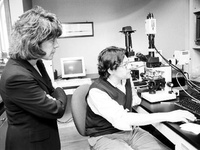“After we do the analysis, the next step is to actually devise a strategy for treatment,” Mancusi-Ungaro explains.
With this painting, microscopic analysis has revealed that the damage may be largely superficial.
Repairs will attempt not to recreate the painting with the same technique Marden originally used, but instead to make the piece look identical to its condition before the accident.
“A conservator tries to use materials in a treatment that are compatible with the original material but also reversible,” she says. “The conservator is trained to match the color as it appears on the surface, including the appearance of dirt.”
Asked what the painting is worth, Mancusi-Ungaro shrugs and refers me to the curator.
“[Conservation] follows the medical model,” she says. “A doctor takes care of a patient no matter the cost.”
According to Harry Cooper, associate curator for modern art for the Fogg, a “major painting” like Marden’s would be worth “certainly over a million dollars.”
Mancusi-Ungaro’s efforts in the Marden restoration have also aided another aspect of her work. She expresses excitement that Marden saved several of the wooden boards that were adjacent to the panels when he painted them in 1980—and that he’s planning on donating them to her collection.
The God of Small Things
She hopes to build the Center for Technical Study into a repository of such materials by collecting “anything of non-commercial value.”
She picks a tube of paint off her desk that’s marked “W.P.A.”—the Works Progress Administration, started by then-President Franklin D. Roosevelt, Class of 1904. The paint in the tubes is still remarkably supple over a half-century later.
“These are the start of the center, right here in my hands,” she says.
Tubes of paint, brushes, discarded boards—these are things that only a conservator could love.
“We need to do it now, before the stuff disappears,” she says. “The information is here. We have a responsibility to document this. Why shouldn’t Harvard be the place [conservators] have to come to for this documentation?”
Coupled with a series of interviews Mancusi-Ungaro has been conducting with artists, the Center’s collection will allow those attempting to restore art in the future—as well as art historians curious about the creation of an artist’s work—to understand the production process better.
Read more in News
New Taqueria Opens on Mt. Auburn St.













